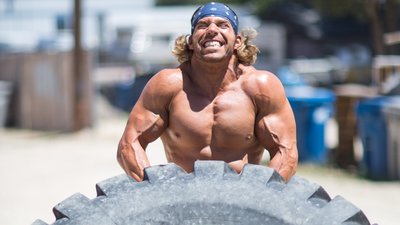There's a reason I don't go to health clubs anymore, and it's not just because more people are yakking more than lifting. No, I'm talking about how people do cardio. Whether it's walking, bicycling, rowing, or stepping, they remind me of hamsters spinning away on a wheel.
You'll never see me on one of those cardio contraptions, because I've found a better way to improve my conditioning and burn off body fat—and it even builds muscle! I call it King Kongditioning, and it'll turn you into a beast!
If you want to get super-conditioned to look like the statue of David and put fun back into cardio, start by dragging that treadmill out to the street and smashing it repeatedly with a sledgehammer. Kidding. But the key is to move heavy shit really fast.
Build Muscle, Increase The Burn, Look Cool
I'm not alone in my disdain for hamster cardio. Over the past decade, we've seen a huge renaissance in the fitness world. The movement is driving people away from assembly-built machines doing the work and instead focuses back on the human machine. Spread in part by the expansiveness of social media and CrossFit, we've see a resurgence in serious, hard-and-heavy old-school training.
You know what's really cool? Picking up a 200-pound tire in the middle of a parking lot and flipping it past all the cars. Put that on your IG!
Moving heavy stuff quickly is superior to plodding along on a machine because the movements are challenging, and you use several different muscle groups at once. As a result, you're burning a lot of calories. The calorie-burning effect from highly intense training also spills over for hours after you complete your training session, which means even more calories are chewed up.
While you can get these benefits from high-intensity interval training, HIIT lacks the coolness factor of flipping tires.
Another big advantage of moving heavy objects quickly is that you can actually put on muscle while doing your conditioning! Look at the quads of elite-level short-distance track cyclists or Olympic skaters. These athletes build tremendous lower-body strength and size with similar styles of training.
Still want to look like a marathon runner? By all means, keep up the low-intensity stuff!
Train Like The King Of Beasts
Not unlike HIIT, Kongditioning should be done in rounds with time periods of rest interspersed between high-intensity activity. Although measuring and tracking your heart rate is one of the best ways to perform HIIT, your fitness level, age, and other factors play significant roles.
Instead of messing with a heart-rate monitor, simply keep in mind that your work sessions should be ones in which you're training at about 70-80 percent of your maximum effort. Your recovery intervals are as long as it takes for you to resume a normal conversation without losing your breath, otherwise known as the "talk test." That sets the upper and lower bounds of your high-intensity and recovery intervals.
What does a work session look like? I like to string 3-4 different push/pull/carry/throw movements in a row and keep that entire sequence to under two minutes. Alternating work and recovery for five or more segments is how you approach Kongditioning.
Kongditioning Guidelines
- Scale all exercises and loads so you work out at 70-80 percent of maximum capacity, or a "rate of perceived exertion" of 7-8 on a scale of 10. An RPE of 8 means you're working just short of all-out, and a 7 means backing off just a bit more. The RPE for most exercises in this program corresponds not with reps but rather with distance.
- Beginners may want to start off at an RPE of 5-6 and work their way up as they get stronger; still, try and do four movements in a circuit before resting. Increase the intensity a little every workout.)
- Like HIIT cardio, the work intervals are intense—you shouldn't be able to maintain that intensity for long durations.
- Distances are roughly 90 feet for each movement, whether it's a walk, carry, or run. That may be what you have in your gym's parking lot, or you may have to cover a 20-foot span four times. Regardless, that's the length we're shooting for here.
- String together four exercises for 90 feet each in fewer than 2 minutes if possible. For recovery, take as long as you need to return to a breathing rate that allows you to carry on a conversation without losing your breath. Over time, decrease the amount of time it takes you to complete the circuit and your recovery time.
- Don't feel constrained by lack of equipment. Substitute barbells, dumbbells, a trap bar, or other tools if you don't have what you need. Make this an inventive workout by combining all kinds of equipment at your disposal.
- Complete the circuit five more times, changing exercises if desired. Add more circuits as your conditioning improves.
Sample Conditioning Exercises
- Weighted farmer's walk: 90 feet
- Weighted yoke carry: 90 feet
- Prowler sled push or pull: 90 feet
- Prowler sled tug-of-war drag: 90 feet
- Harness hip sled pull (backward or forward): 90 feet
- Sandbag carry (do half distance on one shoulder, then switch): 90 feet
- Sandbag walking lunge: 90 feet
- Tire flip: 90 feet (use a smaller auto tire or larger one depending on your strength)
- Keg carry: 90 feet
- Medicine-ball chest pass (against wall): 30 sec.
- Medicine-ball toss (against upper wall): 30 sec.
- Medicine-ball rotational throw (against wall): 12 per side
- Sledgehammer tire smash: 20 reps
You can even add a rowing machine or an AirDyne bike right in the middle for a timed speed event if you'd like to mix things up a bit.
Be creative when combining movements in the circuit by strategically placing objects. For example, start with a sandbag and medicine ball at one end, and have a tire and sled positioned 90 feet away. Carry the sandbag, unload it onto the sled, do your tire smashes, then push the sled (with sandbag) back to the start. Go right into medicine-ball chest passes against the wall, and you've completed one circuit.
Your cardio workouts will never be the same again.



